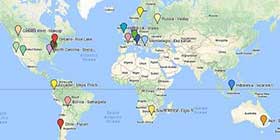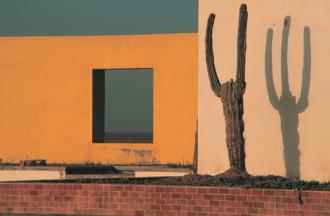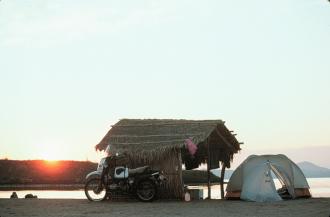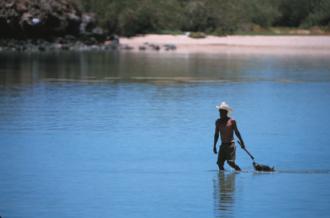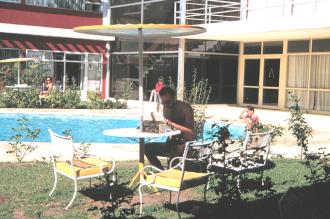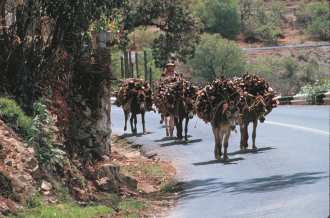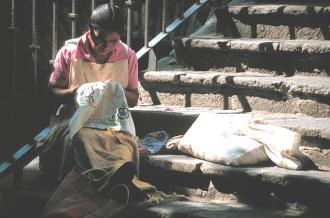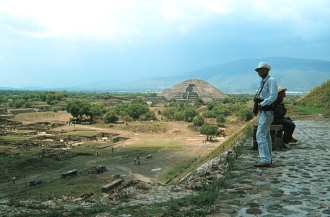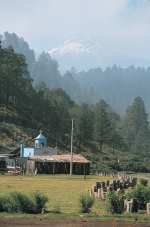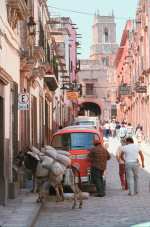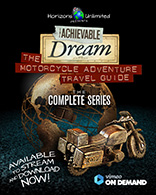Grant and Susan in Mexico
Baja California, Mexico - April 29 - May 18, 1987
Abandoned building in Baja
There isn't a lot in Baja California, other than ocean and desert. This is Mexico's last frontier, and although the highway was paved down the Peninsula in 1973, not much economic development followed it. A lot of money has obviously been spent here, but to our eyes, not very successfully. There are a lot of partially completed abandoned dwellings, and even a whole abandoned school, the Escuela Normal del Desierto it's called, school of the desert, near Guerrero Negro. Either they ran out of money, or someone sensible looked at the population base and said "who's going to go to this school?" I think when the highway was finished, a real population boom was expected, and never materialized.
Quite a lot of effort has also been put into farming, and where the land has been irrigated, it's quite lush. Otherwise, it's almost all desert, very much like Texas. I'm really surprised how many different varieties of cactus there are, some quite exotic and very tall (30 feet or more).
The roads in Baja, at least the main road, Mex 1, is comparable to the Trans Canada in B.C. One lane, and fairly curvy stretches. The difference is in the level of maintenance (pretty low) and probably in the original quality of the construction. Cows graze all along the road, and more than once we've had to swerve or stop to avoid hitting one on the road itself. Driving at night would be fairly dangerous, so we are always off the road by 6:00 or earlier. Once off the main road, in towns, for example, the road deteriorates fairly quickly to broken up asphalt or just gravel or dirt.
We've been camping some times and motelling it other times, depending on availability of camp sites and our mood. There are no problems camping in Baja, unless you want amenities like hot showers, electrical hookups for R.V.s, etc. Our present camp, which consists of palapas (grass huts) on the beach, with outhouses and garbage disposal, costs $3,000 pesos a night, approximately $3.50 Canadian. The palapas are really useful for shade and protection from the wind, so its a pretty good deal. Temperature has been pretty warm here, about 35 Celsius in the shade. Some days, the coolest thing to do is just sit in the gulf, with a hat, long sleeved shirt and sun glasses on.
Bike in front of our palapa, El Requeson beach, Baja California
Most of the people we've met have been Americans, usually from California. This place is rather far to drive to from anywhere else, although we've seen Nevadans as well. A lot of retired couples in trailers, and younger people in VW Vans, the favorite form of transportation. The couple next door to us have a large van, a kayak, a windsurfer, and an inflatable boat with an outboard motor, just to mention their larger possessions, and somewhere in there is the kitchen sink. And down the way, there's a huge R.V. with a car in tow. Some people like to make sure they take everything with them when they get away from it all.
Neither of us have had any bouts of turista yet. The books all say it's inevitable, but Susan is operating on a theory of gradual introduction of new bacteria to your system. We have been mostly cooking our own food, drinking bottled water, etc., but we also have been eating some restaurant meals and eating fresh fruit (washed or peeled). So, she figures our bodies are gradually adjusting to the bacteria, and maybe we'll avoid turista completely.
Cooking is certainly a challenge. No refrigeration means you have to be careful to not create leftovers, or leave anything for very long. Grant eats everything and lavishes praise on all, even when it's not that great. We have been getting fresh vegetables and canned goods in Mulege, about half an hour's drive from here.
Fisherman bringing in his catch, Baja California
The tiendas (grocery stores) in Baja vary from being almost as well stocked as your average small independent grocer to having almost nothing to sell except tortillas. We haven't been able to find ice yet, so are getting used to drinking warm water and pop. Bottled water is available everywhere, at about $1.00 Cdn. a gallon. You could easily turn vegetarian after a walk through the meat departments in the stores which do have them. They are pretty awful, the meat looks old and smells bad.
Mexico is a good place to get mellow, and Susan's Spanish is improving rapidly, especially the vocabulary, while mine is hopeless.
Guadalajara, Mexico - May 26, 1987
Finally, the heat impelled us to move south in search of cooler temperatures (does that make sense?). We took the ferry from La Paz To Mazatlan (16 hours sleeping on deck, since the interior was very crowded and sweaty and reeked of diesel fuel.)
It's not exactly the B.C. ferries, but after all the jokes about the B.C. ferries, you'd really appreciate them after the Mexican ferries. The price is pretty incredible, though. About CDN$1.50 for both of us and the bike for the crossing. Then they charge US$25.00 for 3 minutes for a phone call from here to Vancouver. There isn't much logic to it. Phones and postage are expensive, ferries, buses and subways are dirt cheap. About 5 cents to ride the Mexico City subway system, which is very nice, pretty clean and efficient (Made in Canada).
We stayed a few days in Mazatlan, recovering from the ferry ride and taking advantage of the cheap hotel rates in May/June. We stayed in a nice motel across from the beach, with a pool, restaurant and air conditioning, for about $14. CDN a night. May/June is a good time to visit Mexico, as it isn't too hot yet, and not raining, but the tourist season is over and so hotel rates are discounted heavily. Except for Cancun, but I'll get to that later.
Computing by the pool, using solar panels for power
We headed inland from Mazatlan to Guadalajara, through the worst driving conditions that we had encountered up till then. Still 2 lane (1 each way) highway, as in Baja, but 5 times the volume of traffic, and quite hilly. The majority of the traffic (90%) is trucks, and they go up hills at about 5 Mph.
By the time we got to Guadalajara, we were exhausted from the heat and the driving. We checked in to a hotel which seemed reasonable and had air conditioning for about CDN$10.00. That night, I had my first case of turista, (so much for my theory about gradual introduction of bacteria to the system), and discovered that the bathroom had cockroaches. Reduced to whimpering piteously for Grant to come and kill them (4 enormous cockroaches poised to leap on me and devour me), I spent a most unhappy night. Next morning we went upscale a little, and no more cockroaches.
Guadalajara is quite a modern city, a huge contrast to the small towns in Baja and from Mazatlan in. In the towns, the only evidence that this is the 20th century and not the 19th is the pickup trucks in the streets. Life hasn't changed much for the average campesino in a hundred years. Guadalajara was the first place we saw Mexican middle class in large numbers. Shopping centres which mirror any in Canada, with good selections of everything, and heavily American influenced in clothing, music and food.
The traffic is harrowing, but Grant says his road racing experience was good practice for it. We've been here since Friday, getting welding work done on the top box, which was cracking. It's all reinforced now, as well as fixed, and I have added some welding terms to my Spanish vocabulary, which is growing rapidly.
Donkeys hauling firewood, Mexico
Guanajuato, Mexico - May 28 - June 1, 1987
From Guadalajara, we headed east to Guanajuato, a really interesting colonial town near Mexico City. The town is built on several levels, with an underground street system in addition to the one aboveground. It has some beautiful churches, old castles and mines, and the most macabre tourist attraction we'd ever seen. Evidently, it used to be the custom to continue charging the survivors of a dead person for "perpetual care". If they didn't pay, the corpse would be dug up.
Thus they discovered that something in the soil around Guanajuato has a preserving effect on some bodies. Not perfectly preserved, though. Anyway, they put these "mummies" on display in glass cases, partially decomposed. They look like something out of a horror movie, all sizes and shapes. And they sell souvenirs nearby. The Museum of the Mummies is supposed to be a big hit with the Mexican tourists especially. Anyway, despite the mummies it is quite a nice town, with lots to photograph.
Indian woman embroidering
We stayed for about 4 days, then passed through San Miguel de Allende, another colonial town (not as interesting) en route to Mexico City.
Mexico City - June 4-10, 1987
Grant felt that motorcycle racing had prepared him for driving in Guadalajara traffic, and Guadalajara had prepared him (almost) for Mexico City. As soon as we found a motel we parked the motorcycle and took buses or the subway. Drivers in Mexico City are incredibly aggressive, and they hate empty spaces in traffic. Usually they feel a car and a motorcycle should be able to share a space. And they drive very fast. So, it is quite unnerving to drive there.
There's lots to see in Mexico City, though, so we stayed a week, checked out the cathedral and the Museum of Anthropology, all the other tourist attractions. Had a pack slashed on the bus, nothing taken, though, but it was a warning to be alert. At the hotel, Grant chained the bike to a column, so we felt secure about that. In our room we locked up the saddlebags with anything of value before leaving the room for the day. Mexico City was much cooler than the coast, so that was pleasant.
We got our gamma globulin booster at the Canadian Embassy in Mexico City from the embassy doctor. In addition to free shots, we got free advice. He is also the doctor for all the Canadian embassies in South America, and makes the rounds of them all several times a year.
His advice was the usual - boil the water, take your malaria tablets, and don't eat fresh uncooked vegetables, even in nice restaurants.
Teotihuacan - June 11, 1987
After staying a week in Mexico City, we left for Teotihuacan, an ancient Indian city that predates the Aztecs by centuries. It's near Mexico City, and since there are no Aztec ruins of note (the Spaniards flattened them during the conquest), this was the only archaeological site we saw in Northern Mexico. The site is really nicely restored, and has several large pyramids, as well as a whole street of buildings, and hordes of souvenir hawkers. Unfortunately, not much is known about the Teotihuacanos, neither where they came from or where they went, since the city had been abandoned long before the Aztecs arrived.
We've both read the novel Aztec, which gives an interesting, if violent perspective on the history of Mexico's conquest by the Spaniards. So, that makes the archaeological sites more interesting. To me, anyway. Grant finds them fascinating already, and takes quite a few pictures. We still have not seen any of the sites I mentioned in this area, so that should occupy us for awhile.
Grant at the Temple of the Sun, Teotihuacan
We camped on the site that night, and were woken around 10:00 (early to bed, etc.) by some friendly locals who wanted to warn us it wasn't safe to camp there because of thieves. How to improve your sleep. We survived unscathed, after explaining that we were armed to the teeth, and not afraid of burglars, etc. Our arsenal is rather impressive - no guns, but bear spray (more potent than MACE), flare guns, dagger, a switchblade, plus assorted small knives. And of course, I could practically disable a bad guy with my bare hands after my self defense course. (Someone has to protect Grant, and he sleeps securely at night knowing I'm there.) He doesn't get to read this letter, either.
Veracruz, Mexico - June 14-16, 1987
The next night, heading east, we camped in a National Park, pine forest at 10,000 feet. Beautiful and cool, it reminded us of home, with a great view of Popocatapetl. Then we descended to the coast at Veracruz. What a contrast. Feels like a steam bath! We found a nice motel near a modern shopping centre, and with air conditioning in the room it was bearable. Just. It's not a place I'd recommend, or come back to, though. Not much of interest, and the beaches are dirty. Mexico's oil boom on the Gulf of Mexico has created a lot of employment in the area, and hotel prices are relatively high for Mexico. The same was true for Villahermosa and Campeche, also on the Gulf.
Merida was a nice contrast. Although we only stayed overnight, we plan to go back there on our way out of the Yucatan to Chiapas.
In the Yucatan, we discovered what Rainy Season really means. The rain is pretty impressive here. Campeche was raining so hard for so long, the streets had a foot of water running in them. The bike threatened to stall, and then finally did, and I was afraid I'd have to push it. Luckily, Grant got it going again, and we found a motel. But, we were drenched, even with rain gear. We spent the next hour trying to hang everything, and I mean everything, up to dry. It rained all evening and night, we were beginning to think the town would slide into the ocean. When we asked if this weather was unusual, we were told "not really". The rain is warm, though, unlike Vancouver, and it does cool things down.
Cancun, Yucatan - June 21 - July 17, 1987
Cancun is a magnificent con job being perpetrated on hundreds of thousands of tourists. Cancun is easily the most expensive town in Mexico, twice the price of hotels anywhere else. And it's absolutely swarming with tourists. There doesn't seem to be an identifiable off season, not like the west coast. The town itself is not impressive, considering it's less than 15 years old. The beaches are nice, but when we found out the cost of a hotel room we decided to head south along the Caribbean and find a campground.
Cancun has lots of services, shopping, restaurants, etc. for tourists, since it was a planned development, but why anyone would come to the Yucatan in summer escapes me. Ever since Veracruz, it's been like a steambath, when it's not actually raining.
The Caribbean is lovely here, very warm and not too rough. Quite different from the Pacific, at least the North Pacific. The water is lovely and clear. Scuba diving and snorkeling are supposed to be really excellent, especially on the island of Cozumel, just across from here. And there are lots of interesting Mayan ruins within a short drive or bus ride, at Chichen Itza, Tulum and Coba.
Now we're staying in a nice camp near Playa del Carmen, about 1/2 hour south of Cancun. Lovely beach, cool breezes, a grass hut, showers for $3.00 a night. That's more like it. And we have the place almost to ourselves. We come into Cancun to check for some packages we're expecting, shop and do laundry.
So far, travelling together has been pretty good. Being with each other 24 hours a day can put quite a strain on a relationship, but we're doing okay. Mexico has been a good intro for Central and South America. We're used to inefficiency, delays, shortages, heat, bugs and general inconvenience, all of which will be the norm further south. I already appreciate Canada more than I did 4 months ago.
But, moonlit beaches, sea birds and crabs, and warm oceans to swim or snorkel in, and the luxury of time are worth giving up a few conveniences for. So, we're not tired of travelling yet. I'm still unwinding. I may be ruined from ever working productively again, so we'll have to live off Grant's pictures.
Yucatan final story - July 23, 1987
We spent over a month in the Yucatan, growing progressively more frustrated at the Mexican post office and Customs bureaucracy, while we tried to extricate a parcel which had arrived the end of June. We arrived June 22 in Cancun, checked the following Monday at the post office, and were informed that, yes, a parcel from Spokane, Washington had arrived, and was being held at the post office pending the customs office calculation of duties payable, which was expected to take a week. Dutifully, we returned a week later, to be told the form had still not arrived from Customs. If we wished to inquire further, we could go to the Customs office at the airport (about 10 minutes drive from town).
We took ourselves out to the airport that morning, were told the Customs official we should speak to, Mr. Toledo, would be on duty from 3:00 p.m. that afternoon. We returned in the afternoon, and Mr. Toledo, who was very helpful, said that although he was not the official who had prepared the form, (personnel change shifts at the middle and end of the month), he would personally go to the post office the next morning and look for the customs form. If we came to the post office around 11:00, it should be ready.
The next morning at 11:00, Mr. Toledo informed us at the post office that the form was not there, that we should go to the main Customs office at the airport and inquire for Mr. Carro, who was the official who had prepared the form. Back out to the airport, we arrived at the Customs office and asked to speak to Mr. Carro. Sorry, Mr. Carro is on a course in Mexico City for a month. No record of the form having been completed, he probably took it with him to Mexico City! I explained we could not wait a month until Mr. Carro returned, as our visitor permit was going to expire, and they seemed to realize that was a little unreasonable. Mr. Toledo's supervisor directed us to go to the Post Office the next day (Thursday) at 6:00 p.m., and Mr. Toledo would have prepared a new form for us.
By Thursday evening, the new Customs form had indeed been prepared, but the Post Office officials now had to check the calculations, and it would be Friday at 8:30 a.m. before the parcel was ready to be picked up. Finally, after a solid week of trying every day, we picked up the parcel Friday morning, two weeks after it had arrived. Everything intact, and the duty was minimal, so we were grateful for that. And lo and behold, the form was signed by the missing Mr. Carro! So, probably it was lost in the post office all along.
Anyway, we were actually relieved that no other packages were coming via the post office. We arranged with Toshiba in Mexico City to courier the computer parts to Cancun, and with American Express in Cancun to take delivery of them, and all that proceeded very quickly and painlessly in a matter of several days. We decided any future packages we'll have sent by courier, since the extra charge is more than offset by increased living expenses if we have to wait several days or weeks for a package to arrive.
The painful part was trying to phone Spokane and Vancouver to find out the status of the other packages. Long distance phone calls in Mexico are obscenely expensive, about $30.00 for 3 minutes, and $9.00 a minute afterwards. Collect calls don't seem to be appreciably cheaper. Obviously, they use the revenues to subsidize ferries and buses. To add insult to injury, it can literally take several days to get a call through, since the International Operator seems to only answer the phone about half an hour out of the day. I finally resorted to bribing the local telephone operator, promising a bonus of 5,000 pesos ($5.00 Canadian), for a completed call.
We spent several days snorkelling in the lagoons and coves in the area. Xelha Lagoon (pronounced Shelha) is an underwater park, with thousands of fish. They rent snorkels and fins there, and underwater cameras, and there is a restaurant, showers and changing rooms, as well as the ever present souvenir shops. But, it really is a delightful experience, like swimming in a giant aquarium. Xcaret (Shcaret) is less developed, and right on the ocean, so there are more currents, but still very nice. I feel like an accomplished snorkeller now. We got a good price on fins and snorkels in Cancun, so got a pair of fins and snorkel each. We strapped them on top of the top box, next to the cooler! We'll try to sell them when we get further south, since it isn't worth the postage to mail them home. Maybe we'll take them all the way to Australia, and use them on the Great Barrier Reef!
Unfortunately, Grant picked up an infection of some kind diving in a cenote (ceremonial pool). After several days of 102 fever, severe headache and diarrhea, we started him on our supply of antibiotics. That seemed to help, got rid of the fever and headache, but since our tourist card for Mexico was about to expire, we decided to travel on to Belize and Guatemala before he was completely well, and he caught a bad cold on the way.
Member login
Announcements
Thinking about traveling? Not sure about the whole thing? Watch the HU Achievable Dream Video Trailers and then get ALL the information you need to get inspired and learn how to travel anywhere in the world!
Have YOU ever wondered who has ridden around the world? We did too - and now here's the list of Circumnavigators!
Check it out now, and add your information if we didn't find you.
Are you an Overland Adventure Traveller?
Does the smell of spices wafting through the air make you think of Zanzibar, a cacophony of honking horns is Cairo, or a swirl of brilliantly patterned clothing Guatemala? Then this is the site for you!
Hosted by Grant and Susan Johnson, RTW 1987-1998
Johnson's Home
Who Are We?
The BIKE Story
Press Stories about us
Our "Rules of the Road"
Photo Album 500+ images
"Quick" highlights -
Top 31 photos
Mexico
Central America
New Zealand
Australia
Europe
England
Isle
of Man
Norway
Sweden
Denmark
Germany
Netherlands
Spain
Gibraltar
Africa
Tunisia
Libya
Egypt
Kenya
Tanzania
Malawi
Zimbabwe
Botswana
Namibia
Caprivi Strip
Etosha
Sossusvlei
South
Africa
South America
Argentina
Tierra del Fuego
Chile
Peru
Ecuador
Colombia
Next HU Events
HU Event and other updates on the HUBB Forum "Traveller's Advisories" thread.
ALL Dates subject to change.
2024:
- California: April 18-21
- Virginia: April 25-28
- Germany Summer: May 9-12
- Québec: May 17-19
- Bulgaria Mini: July 5-7
- CanWest: July 11-14
- Switzerland: August 15-18
- Romania: August 30-Sept 1
- Ecuador: August 24-25
- Austria: September 12-15
- France: September 20-22
- Queensland is back! Date TBC
- Germany Autumn: Oct 31-Nov.3
- South Africa: November
Add yourself to the Updates List for each event!
Questions about an event? Ask here
HU Achievable Dream is Online
and available now to stream on Vimeo!
ALL 15 chapters of the HU Achievable Dream Guide are available to download on Vimeo!
Binge watch over 18 hours of inspiring, informative and entertaining stories and tips from 150 travellers!
"a cross between entertaining stories, tech tips, and reference guide"
"A timeless introduction to Motorcycle Adventure Travel!"
Originally launched as a 7 DVD set, The Achievable Dream series can now be downloaded anywhere. OVER 18 hours of solid info take up zero space in your panniers. How convenient!
Books

All the best travel books and videos listed and often reviewed on HU's famous Books page. Check it out and get great travel books from all over the world.
NOTE: As an Amazon Affiliate we earn from qualifying purchases - thanks for your help supporting HU when you start from an HU Amazon link!







